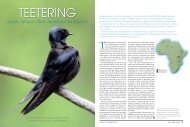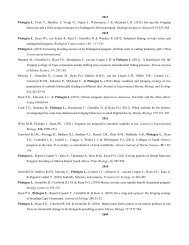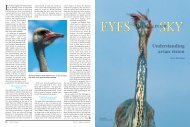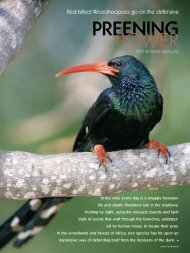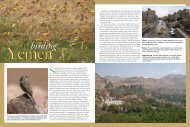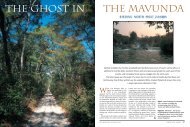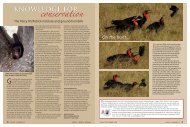binoculars - Africa Geographic
binoculars - Africa Geographic
binoculars - Africa Geographic
Create successful ePaper yourself
Turn your PDF publications into a flip-book with our unique Google optimized e-Paper software.
user’s guide to <strong>binoculars</strong><br />
© canon<br />
whether they were suitable for use with<br />
glasses, aesthetically pleasing and on<br />
their apparent robustness. We also noted<br />
whether the manufacturer claimed they<br />
were waterproof, but didn’t put this to<br />
the test. Finally, we checked for useful<br />
accessories, such as a rain-guard.<br />
Before the rest of the panel arrived,<br />
I prepared a batch of assessment forms<br />
and set out all the <strong>binoculars</strong>. (It’s easy<br />
to see why <strong>binoculars</strong> arrive with their<br />
straps neatly folded away – it’s too labour<br />
intensive to fit them! Why do many<br />
manufacturers make it almost impossible<br />
to fit the straps through the lugs<br />
on the body of the bins) After more<br />
CANON IS 12x36<br />
than an hour of fiddling, the <strong>binoculars</strong><br />
were ready for testing. Once the panel<br />
got down to work, there ensued eight<br />
hours of concentrated assessment, as<br />
we tried each pair to get an idea of the<br />
range of products on offer, then did it all<br />
over again to do the actual scoring. At<br />
the time, we didn’t know the prices of<br />
the various products (other than having<br />
a rough notion for the top end of the<br />
range). All the scores were then combined<br />
and each pair of <strong>binoculars</strong> was<br />
given a 1- to 5-star rating for optics and<br />
feel. The sum of these ratings was then<br />
divided by the cost (using an arcane<br />
transformation) to come up with an<br />
index of value for money. The results are<br />
summarised in the table on page 62.<br />
The Cheapies<br />
Of the 36 pairs reviewed, 26 cost more<br />
than R1 500. The remaining 10 were<br />
either porro-prism (big, clunky <strong>binoculars</strong>)<br />
or small, compact bins designed<br />
for slipping into your pocket or taking<br />
on a hike when weight is a serious issue.<br />
The porro-prisms didn’t rate too badly<br />
for optics, but for the most part fared<br />
poorly in terms of feel and robustness.<br />
Almost all have external focusing (the<br />
eyepieces move in and out to focus),<br />
which pretty much precludes them being<br />
waterproof, and from experience we<br />
have found that they are easily knocked<br />
out of alignment. The one exception<br />
is the Leupold Yosemite 6x30, which<br />
has internal focusing and is claimed to<br />
be fully waterproof. It is small, compact<br />
and as cute as one can imagine<br />
a pair of porro-prism bins getting, but<br />
its relatively low magnification is probably<br />
insufficient for most birders.<br />
Some of the compact <strong>binoculars</strong> were<br />
quite reasonable, but their field of view<br />
tends to be limited. If you are shopping<br />
in this price range, we’d consider<br />
the Canon 8x23 compacts, which are<br />
claimed to be waterproof and look more<br />
robust than most. Unfortunately, we<br />
didn’t get to test the Canon 8x32 WP<br />
which looks like an even better entrylevel<br />
option. If you are considering a pair<br />
of porro-prism <strong>binoculars</strong>, the Nikon<br />
Action 8x40 is reasonably priced and<br />
has a tolerable close-focus distance. All<br />
the others are pretty hopeless, not even<br />
focusing on birds five metres away.<br />
Roof-prisms rule<br />
Only one pair of <strong>binoculars</strong> costing more<br />
than R1 500 weren’t the vastly superior<br />
try before you buy If you are considering buying a pair of <strong>binoculars</strong>, check the following points.<br />
3 How do they feel when you hold them Are they nicely balanced<br />
and not too heavy<br />
3 Is the focus wheel accessible and easy to use<br />
3 Can the adjustable eyepiece be locked to suit your eyes<br />
3 How do the eye-cups feel Can they be locked at a level that suits<br />
your eyes<br />
3 Is the close-focus distance three metres or less<br />
3 How fast is the focus (It shouldn’t take more than 0.7 rotations<br />
of the focus wheel to go from five metres to infinity.)<br />
3 Is the field of view adequate (As a general rule of thumb, avoid<br />
anything where the objective diameter divided by the magnification<br />
is three or less.)<br />
3 Is the image nice and bright Are the colours true to life<br />
3 Is there excessive chromatic aberration (Look for ghostly blue<br />
or yellow edges to objects when viewed towards the edge of the<br />
field of view.)<br />
LEUPOLD YOSEMITE 6x30<br />
3 Is the focus sharp across the field of view, or does it get soft<br />
towards the edges<br />
3 Is the image flat (Try panning quickly and look for bulging in<br />
the central portion of the image.)<br />
3 Is there a problem with flare Ask to take the <strong>binoculars</strong> outside<br />
and look towards the sun (but not at it, as that can seriously<br />
damage your eyes!). Does the image get washed out by ghostly<br />
internal reflections<br />
3 Are they robust<br />
3 Are they waterproof Is there any guarantee if they leak Having<br />
nitrogen-filled <strong>binoculars</strong> ensures they are sealed, and prevents<br />
internal fogging or problems with fungal growth on the lenses.<br />
3 Is there a rain-guard that you can leave attached to one of your<br />
neck straps<br />
3 Are there objective covers, should you want them<br />
3 Is the strap comfortable (Bear in mind that this can be replaced.)<br />
roof-prism design. In addition to their<br />
more compact and comfortable shape,<br />
roof-prisms allow for greater robustness,<br />
fully internal focusing and true waterproofing<br />
(but beware – not all roofprisms<br />
are truly waterproof!). If you<br />
can afford it, we strongly recommend<br />
investing the extra money and buying<br />
a pair with roof-prisms. The only pair<br />
of porro-prism bins in this price range<br />
was the Pentax XCF 10x50, which is<br />
claimed to be waterproof, but is very<br />
large, heavy and awkward to use, and<br />
has the bizarre feature of a focus lock.<br />
No one could imagine why this would<br />
be useful to a birder.<br />
Hopefully we’ve convinced you that<br />
roof-prism is the way to go. But now the<br />
field gets more crowded. We were faced<br />
with 25 pairs of <strong>binoculars</strong>, ranging in<br />
price from just over R1 600 to R19 000.<br />
The field here can be divided into three<br />
price brackets: the top end (R15 000 and<br />
up), mid-range (R7 000–R13 000), and<br />
bargain basement (less than R5 000).<br />
ZEISS victory fl 10x42<br />
The top end: R15 000–R19 000<br />
If money is no object, then you’re probably<br />
going to opt for one of the three big<br />
names: Leica’s Ultravid, Swarovski’s EL or<br />
Zeiss’s Victory FL range. All three lived<br />
up to their big-ticket reputations, with<br />
their flagship 10x42 models scoring maximum<br />
marks for optical quality. We were<br />
hard pressed to separate them, with Zeiss<br />
shading the others slightly in twilight<br />
conditions and having a better closefocus<br />
distance. Its main drawback<br />
was its rather large size, which<br />
felt a little clumsy compared<br />
to the competition.<br />
Only Zeiss submitted<br />
a smaller model for<br />
evaluation, the 10x32.<br />
This was equally good<br />
optically, except in twilight<br />
conditions, when<br />
it couldn’t compete with<br />
the larger objective models. However, it<br />
is much smaller and lighter, and would<br />
certainly appeal to the less-macho birder<br />
(or one over-burdened with other gear).<br />
The most expensive model assessed was<br />
Leica’s Duovid, a novel design that offers<br />
8x or 12x magnification by twisting<br />
each eyepiece in turn. It was optically<br />
impressive, apart from a rather mediocre<br />
close-focus distance, but we all felt the<br />
marked increase in weight wasn’t worth<br />
the extra magnification. Rather have a<br />
pair of 10x bins and a ’scope.<br />
Mid-range: R7 000–R13 000<br />
This sector covers a wide range in price,<br />
and comprises such a mixed bag that<br />
it is hard to generalise. Most are conventional<br />
roof-prism <strong>binoculars</strong>, which<br />
fall between two stools to some extent,<br />
being not quite up with the quality<br />
of the top end and not offering much<br />
more than some of the cheaper roofprism<br />
models. Zeiss’s Conquest range<br />
is pretty similar to the top-end Victory<br />
models, but uses a lower quality glass.<br />
The difference is not great until viewing<br />
conditions become challenging (at<br />
dusk or when looking towards the sun).<br />
The 10x40 model is pretty good, but we<br />
all felt the 10x50 was just too large and<br />
heavy to have to carry around all day.<br />
An annoying feature was the lack of a<br />
rain-guard; although you can order one<br />
as an accessory, it seems a pity not to<br />
provide one with what is, after all, still a<br />
pretty expensive pair of <strong>binoculars</strong>.<br />
The other <strong>binoculars</strong> in this price<br />
bracket are the flagship offerings by<br />
a number of other manufacturers.<br />
Leupold’s Gold Ring 10x32 is remarkable<br />
for focusing down to just more<br />
than a metre, although you may start to<br />
feel a little queasy at this range. We all<br />
commented on the uncomfortably large<br />
eye-cups, which might be required when<br />
focusing so close, but they really detract<br />
from the bins’ appeal for everyday use.<br />
SWAROVSKI EL 10x42<br />
Nikon’s HG 10x42 and Bushnell’s Elite<br />
8x43 are more conventional models that<br />
use the best-quality glass in an attempt<br />
to challenge the top-end marques. Both<br />
are nice <strong>binoculars</strong>, but are not quite up<br />
to the standards of the big three. Of the<br />
two, the Bushnell offers better value for<br />
money, and comes with objective covers,<br />
as well as a nifty semi-rigid case.<br />
Perhaps the most distinctive pair of<br />
bins we tested was the Canon Image<br />
Stabilised (IS) 12x36. Canon has had<br />
great success with its IS camera lenses,<br />
and apparently sees IS as the wave of<br />
the future for <strong>binoculars</strong> too, but these<br />
will need further development if they<br />
are going to have a large impact on<br />
the birding market. Available in 12x,<br />
15x and 18x models, the floating lens<br />
system cuts out minor shakes as soon<br />
as you press the centrally-mounted IS<br />
button. But the design takes some getting<br />
used to, with the IS button displacing<br />
the focus wheel from the most<br />
accessible position. The field of view is<br />
a little narrow, the close focus distance<br />
is more than seven metres, and we<br />
had concerns about its ability to withstand<br />
arduous field conditions. And it<br />
is rather unusual to have to carry spare<br />
batteries for your <strong>binoculars</strong>!<br />
Bargain basement: less than R5 000<br />
Rather like the car market, the field gets<br />
crowded at the lower end, with lots<br />
of competitively priced products. It is<br />
this sector that has seen the greatest<br />
growth, thanks to the increase in the<br />
global demand for birding <strong>binoculars</strong>,<br />
and there are some real bargains to be<br />
had. If you’re still birding with a pair<br />
of porro-prism <strong>binoculars</strong> that you <br />
60 <strong>binoculars</strong> africa – birds & birding<br />
december 2006/january 2007<br />
<strong>binoculars</strong> 61



